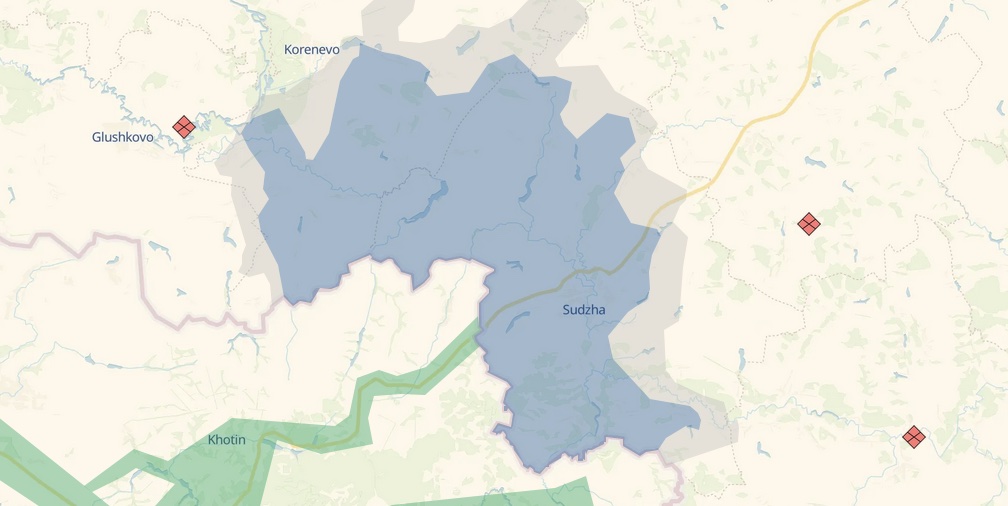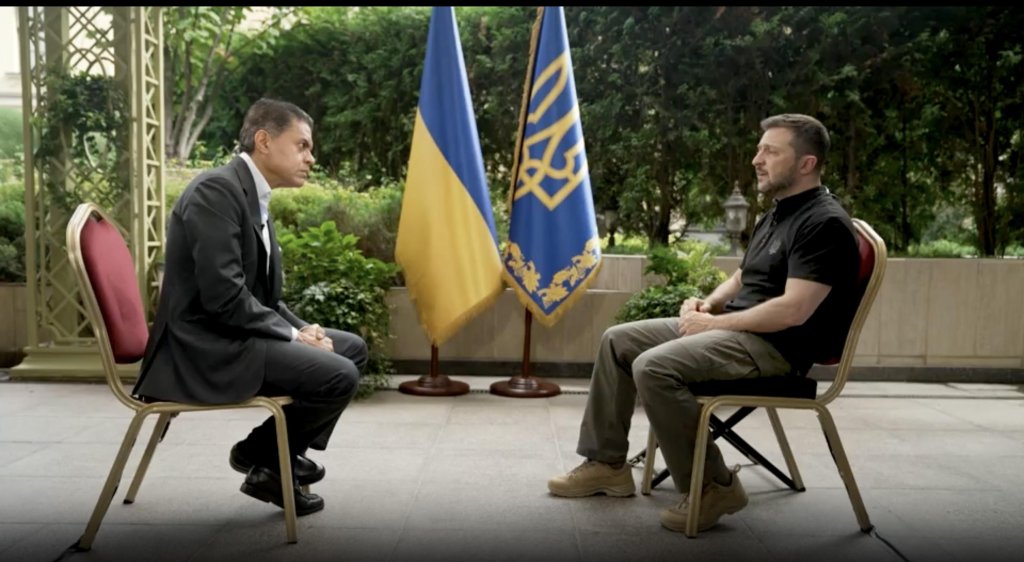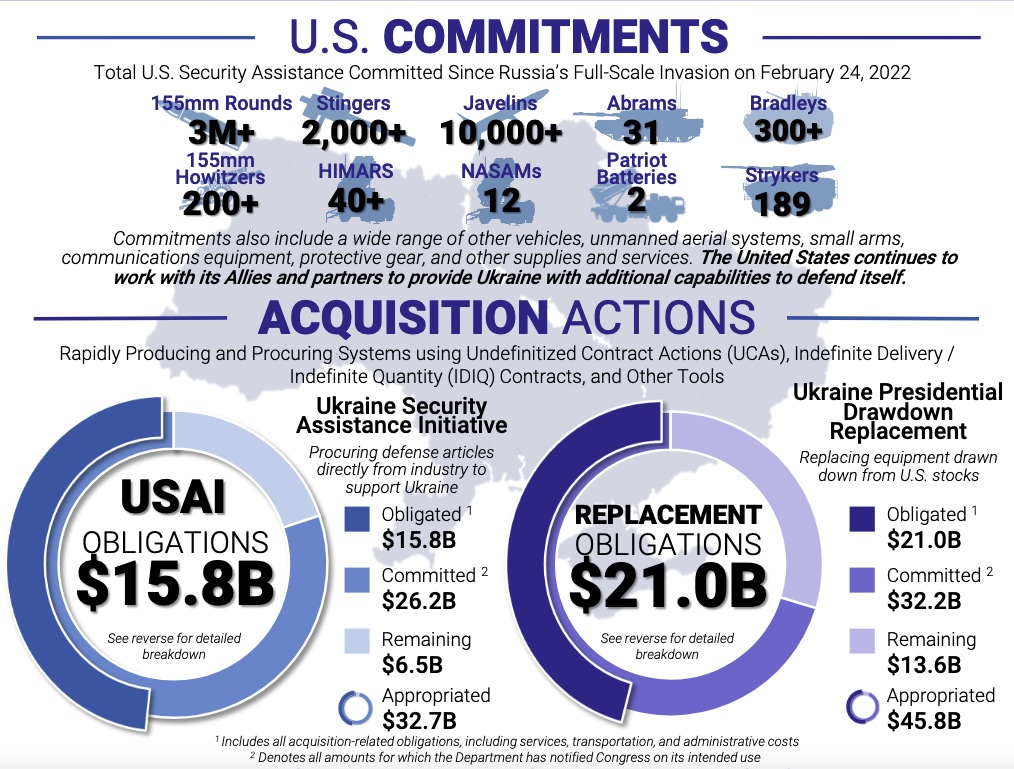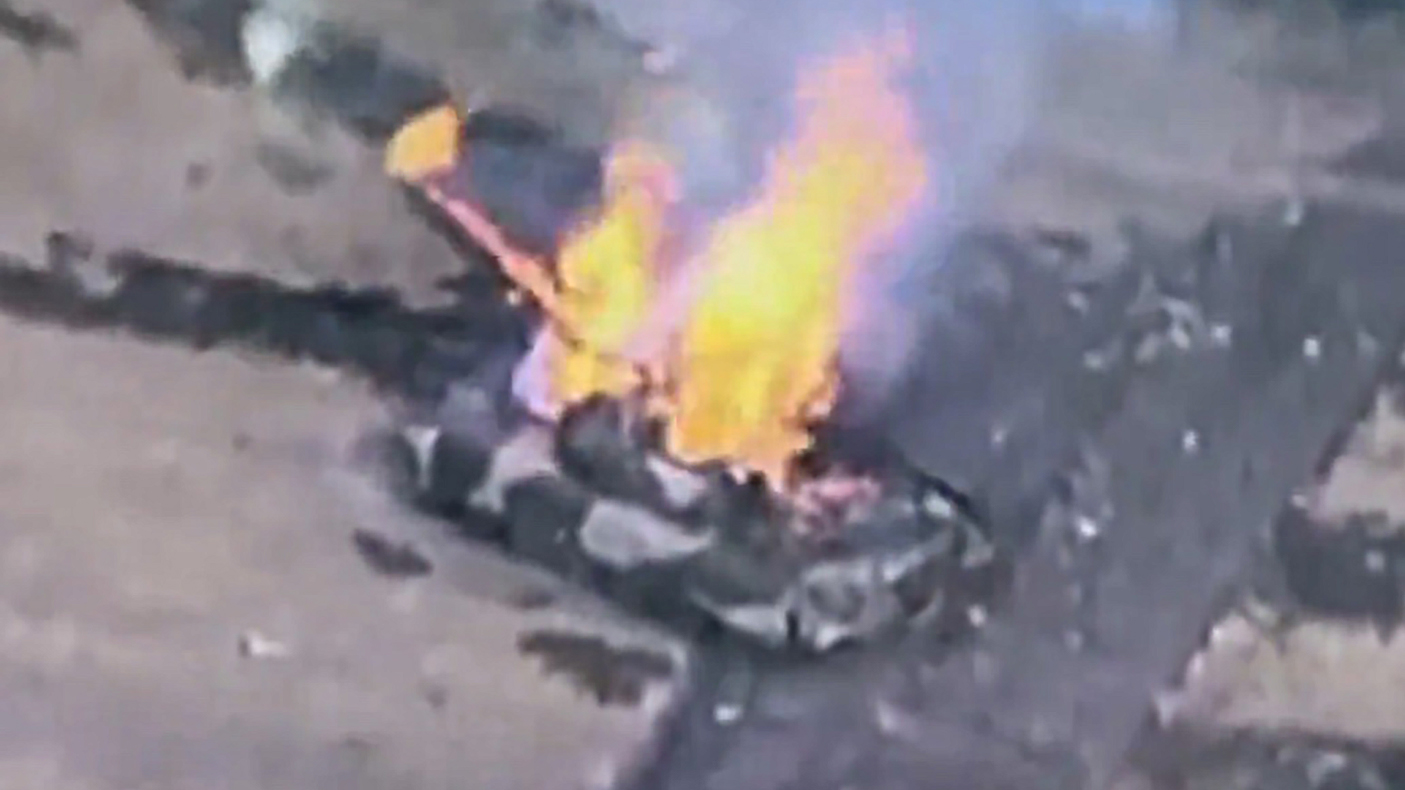More than a month after Ukraine first invaded Russia’s Kursk Oblast, Moscow’s forces have mounted a counteroffensive to try and take back the hundreds of square miles they lost.
Just how effective it has been so far is not quite clear, but indications are that Russia is making a serious bid to kick Ukraine out.
The Russian Defense Ministry (MoD) claims its “Units of the North” forces had reclaimed 10 settlements in two days in the area around Snagost, according to the BBC. That town is on the western flank of Ukraine’s salient.
That is roughly in line with the dynamic control map produced by the Ukrainian DeepState open-source intelligence group. The map shows Russian forces have knifed through the salient, moving about six kilometers south from Korenevo to Snagost.

Ukrainian President Volodymyr Zelensky has acknowledged that Russian forces have launched a “rapid” counterattack but “haven’t achieved serious success,” according to the Kyiv Independent.
“In the Kursk direction, the Russians have started their rapid offensive, and they want to use about 60,000-70,000 people there,” Zelensky said, according to the publication. He also said the counteroffensive “is going in line with our Ukrainian plan,” the BBC noted.
One Ukrainian officer told the BBC that the “fighting is very tough and the situation is not in our favor as of now.” An indication of the ferocity of battle can be seen in the video below shot from the Russian perspective.
Initially, Kursk was lightly defended, allowing Ukraine to capture about 500 square miles of territory. However, Russia began moving more troops and equipment into the region. The units included the 56th Air Assault Regiment to the west, the 810th Naval Infantry Brigade to the north, the 11th Separate Assault Brigade to the east, and the 488th Motor Rifle Regiment and 155th Separate Brigade of Marines to the southeast, according to DeepState. Russia also increased its airstrikes. The fighting grew more fierce and has turned into a full-blown counteroffensive.
Ukraine is not entirely on its heels, according to the Institute for The Study of War (ISW) and at least one of its military units fighting there.
“Russian forces continued counterattacking throughout the Ukrainian salient in Kursk Oblast on September 12 but made only marginal gains, likely due to continued Ukrainian offensive operations and defensive counterattacks in the area,” ISW reported in its latest assessment.
In addition to mounting local attacks on advancing Russian troops, Ukraine has opened up a new front, pushing across the border into the Russian town of Tetkino, ISW stated. As we noted nearly a month ago, Ukraine wants to move east through Tetkino and thousands of Russian troops are estimated to be stuck south of the Seim River thanks to a campaign of attacks on bridges.
Those strikes continue as Russia attempts to build pontoon bridges across the River.
Russian sources reported that a small unit of Ukrainian troops and armor was also pushing west toward that pocket of troops.
“The operational and combat situation remains difficult,” the Russian Senior Border Guard Telegram channel claimed on Friday. “Yesterday, the enemy managed to consolidate its position in the area of the village of Novy Put. After which the enemy made a dash towards the settlement of Veselove consisting of a tank and two armored fighting vehicles, the first attack was repelled. By evening, the enemy began to dig in near Veseloye, continuing the attacks. The enemy is actively destroying our UAVs, which complicates the reconnaissance and adjustment of our artillery. Border guards, together with units of the Ministry of Defense of the Russian Federation, are repelling enemy attacks. Heavy fighting is underway.”
The Ukrainian presence in Veseloe, almost 12 miles west of Ukrainian-held territory in Kursk, was geolocated by an attack on one of its armored vehicles there.
Ukraine’s Khorne Group military unit said it is on the offensive in Kursk.
“We penetrated into a new place for kilometers into Russia….. a group of Russian conscripts of more than one thousand people under the threat of encirclement,” Khorne Group claimed on Telegram.
The War Zone cannot independently verify any of these claims, but it was inevitable that Russia would hit back hard against an invasion of its territory.
The Kursk invasion was launched in large measure to try to draw Russian troops from eastern Ukraine, where they are within a few kilometers of taking several key towns. However, that advance continues, albeit at a much slower pace as Ukrainian forces too have dug in and reinforced their positions. More on that later.
Even before the counterattack, things were getting difficult in Kursk, Ukrainian troops said.
Three days before it was launched, CNN spoke with 14 Ukrainian soldiers from five different units who were deployed to Kursk as part of the incursion.
All 14 said the Kursk invasion “was a difficult operation with casualty rates on par with other parts of the frontlines. They said it was getting tougher, five weeks in, and some even questioned the decision to launch the incursion at a time when Ukraine was struggling to defend key towns and cities in the east of the country.”
“It will get more and more difficult,” one soldier said. “There will be more artillery fire, more soldiers, and there will be very big and difficult battles, but we must do everything we can that improves our position.
Ukraine, said the soldier, “wants peace, but peace when we win, not when we lose. Russia is sending a lot of troops and artillery (to Kursk). We have a lot of guys who have been killed and we have a lot of destroyed hardware.”
Russian President Vladimir Putin has ordered his troops to retake territory lost in Kursk by Oct. 1, a deadline that will be challenging to meet. Zelensky, meanwhile, has indicated he has no intention of a rapid withdrawal from Kursk. He has sent some of his best troops and equipment into Russia even as the eastern part of his nation buckled under a withering Russian advance.
The coming days should provide a better indication of whether Ukraine’s push into Russia was a bet worth making at such a critical time in the conflict.
The Latest
In the heavily contested eastern part of Ukraine, Russian troops are continuing their advance toward Pokrovsk. As we have frequently noted, the city is a key logistics hub for this region. It is nestled by important roads and bisected by a major rail line. Just a little under six miles from the city, Russia is pushing westward toward it, but there are indications that the massive offensive has slowed a bit.
“Over the past 24 hours Russian troops have occupied the village of Lisivka and pushed closer to Pokrovsk, about 10 kilometers distant,” Politico reported.
“As we can see, the Russians put everything in the direction of Pokrovsk,” Ukrainian army spokesman Dmytro Lykhoviy told the news outlet.“They don’t have enough resources to conduct a massive offensive on several fronts at once, and this has been evident for the past few months.”
Still, that town is in trouble and the Donetsk Oblast governor urged the remaining civilians to leave.
“The situation is difficult and will not get better soon,” Vadym Filashkin said on Facebook Thursday. “That’s why I urge you again: evacuate! Evacuation is the only right choice for civilians!”
Russian troops pushing toward Pokrovsk say the offensive force ranges from well-organized modern military units to undertrained troops sent out on assaults with minimal artillery support, no armor or aviation, and are heavily targeted by Ukrainian drones.
Ukraine’s 46th Airmobile Brigade claimed a new record for Russian equipment destroyed in a single attack in the Kurakhove sector of the Donetsk region, about 20 miles south of Pokrovsk.
“On September 12… Four waves of assaults from 5:45 a.m. to noon on the positions of the battalions of our brigade should, according to the enemy’s plan, break through the defense of the Ukrainian paratroopers,” the unit claimed on Telegram. “Tanks, armored personnel carriers, infantry fighting vehicles, infantry on motorcycles – a total of 46 units of armored and not so armored vehicles fell on us. And the record was set! Such a number of destroyed and damaged enemy equipment in one day in the direction of responsibility of the 46th brigade has never really happened.”
The War Zone cannot independently verify this claim, but the video below, first published by the unit, shows the intensity of that battle.
Though U.S. President Joe Biden and U.K. Prime Minster Keir Starmer met in Washington today to discuss among other topics the granting of permission for Ukraine to use long-range weapons in Russia, the results of that meeting may not be publicly known for a while.
“There is no change to our view on the provision of long-range strike capabilities for Ukraine to use inside Russia, and I wouldn’t expect any sort of major announcement in that regard coming out of the discussions, certainly not from our side,” White House National Security Council spokesman John Kirby told reporters on Friday. “I also leave it to the Prime Minister to decide what he wants to talk about.”
While there have been increasing indications that the U.S. will allow Ukraine to uses its Army Tactical Missile System (ATACMS) short-range ballistic missiles inside Russia and the U.K. will do the same with its Storm Shadow air-launched cruise missiles, those permissions have yet to be granted.
In an exclusive interview with CNN, Ukrainian President Volodymry Zelensky continued pushing for the. U.S., the U.K. and allies to allow the use of those long-range fires inside Russia.
“Everybody is looking [for] the decision of the United States, everybody’s waiting for sides’ decisions, after that, they make decisions,” he said. “And so, we wanted very much to use this weapon and just to attack these jets on the military bases, not civilians, infrastructure. Military bases.”
Zelensky said he had meetings with U.S. officials and told them “we waited too long. Now Russia [has begun] to move their jets from 100, 150km, 300 to 500km. After that, I will tell you. And that now we need more permissions. But now you will tell me, maybe we will give you 100 or 200, but for what? To destroy what if they began to move? So we’re again, like with the packages, slow decisions and again, we can’t win in such circumstances.”

Russian President Vladimir Putin warned the United States and its allies not to lift restrictions on the use of these long-range weapons.
“We are not talking about allowing or not allowing the Ukrainian regime to strike Russia with these weapons,” Putin said Thursday in comments to propagandist Pavel Zarubin, according to NBC News. “We are talking about deciding whether NATO countries are directly involved in the military conflict or not.”
While the U.S. and U.K. are mulling over whether to allow Ukraine to use donated weapons on Russian soil, Poland became the latest nation to say there are no such restrictions.
“We shall continue supplying Ukraine with advanced air defense and antimissile defense systems and lift the ban on using long-range weapons,” Polish Foreign Minister Radosław Sikorski said at the joint press conference with U.S. Secretary of State Antony Blinken on Thursday.
Without an extension authorized by Congress, the Pentagon has 17 days to spend nearly $6 billion on military equipment for Ukraine before the funds disappear with the change of the Fiscal Year on Sept. 30.
“We have $5.9 billion left in Ukraine Presidential Drawdown Authority (PDA); all but $100 million of which will expire at the end of the fiscal year,” Air Force Maj. Gen. Pat Ryder said in a statement Friday. “The department will continue to provide drawdown packages in the near future and is working with Congress to seek an extension of PDA authorities beyond the end of the fiscal year.”
So far, the U.S. has committed more than $56.6 billion in security assistance to Ukraine since the beginning of the Biden Administration, including approximately $55.9 billion since the beginning of Russia’s all-out invasion on February 24, 2024, according to the Pentagon.

Russian drones attacking Ukraine have frequently landed on or crossed over the airspace of several nations. However, to date, only Russian client state Belarus has shot one down, an irony Zelensky chided NATO allies about.
“Only Belarus has distinguished itself by shooting down Russian drones,” Zelensky complained. “I think it’s simply humiliating for the strong democratic world.”
The U.S. Ambassador to Ukraine lashed out at Russia for attacking a civilian vessel traveling in the Black Sea with a load of grain bound for Egypt.
“We strongly condemn Russia’s attack on a commercial cargo ship in the Black Sea last night,” Bridget A. Brink said on Twitter. “This escalatory attack is a blatant violation of international law that threatens global food security.”
A Kh-22 supersonic cruise missile fired by a Russian Tu-22M3 Backfire bomber “slammed into the port side of the bulk carrier MV Aya on Sept. 11 in a morning strike,” according to the Kiyv Post. “Reportedly, the weapon was one of three launched by a trio of bombers flying over the Black Sea shortly after 11 a.m.”
The Belize-owned, Turkey-operated Aya “was carrying Ukrainian grain loaded in the port Chornomorsk and was en route to Egypt. At the time the Russian missile struck her, the Aya was in international waters some 15-20 nautical miles off shore. She had been travelling in convoy with other cargo vessels.”
It was the first time a missile has struck a civilian vessel transporting grains at sea since the start of Moscow’s invasion in February 2022, according to Reuters. Some vessels have been damaged during Russian attacks on Ukrainian ports where they were moored.
Ukrainian pilots arrived in Romania “a few days ago” and have already started training to fly F-16 Vipers, according to Euromaidan Press.
Ukraine’s Defense Minister Rustem Umerov previously announced the start of training for Ukrainian pilots on F-16s in Romania after a conversation with his Romanian counterpart Angel Tîlvăr, the publication reported.
It marks the first time Ukrainian pilots will train on Western jets in Romania. The Ukrainians are expected to begin flight training by October 2024.
At the latest count, around 85 F-16AM/BMs have now been committed to Ukraine. These comprise 24 from the Netherlands, 19 from Denmark, and 12 from Norway (with the same country providing 10 more that will be used for spare parts), while Belgium says it will supply 30. Greece has also since been suggested as a possible source of more of the fighters, of the F-16C/D Block 30 version.
The Pentagon is spending $1.2 billion in a contract modification for a new batch of AIM-120 Advanced Medium-Range Air-to-Air Missiles, or AMRAAM. Those are among the munitions that can be fired by Vipers.
“This modification adds additional production of the AMRAAM missiles, AMRAAM telemetry system, initial and field spares, and other production engineering support hardware and activities,” it states on its website.
This contract involves Foreign Military Sales to Bahrain, Bulgaria, Canada, Finland, Germany, Hungary, Italy, Japan, Norway, Switzerland, Ukraine, and United Kingdom.
Last year, Russia started producing a new long-range attack drone called the Garpiya-A1 using Chinese engines and parts, Reuters reported. The drones have been used Ukraine the publication said, citing two sources from a European intelligence agency and documents seen by Reuters.
“The intelligence – which included a production contract for the new drone, company correspondence on the manufacturing process and financial documents – indicated that IEMZ Kupol, a subsidiary of Russian state-owned weapons maker Almaz-Antey, produced more than 2,500 Garpiyas from July 2023 to July 2024,” Reuters stated.
Ukrainian forces struck an ammunition dump in the occupied Azov Sea town of Mariupol, according to an advisor to the city’s mayor.
“Arrival in Mariupol district. The attack has been going on for half an hour, Russian air defense is not capable,” Petro Andriushchenko wrote on Telegram. “Detonation is present immediately after impact.”
Video emerged on social media purporting to show the aftermath of that attack, with several large fires burning and explosives cooking off.
Three train cars filled with oil near Chernivhiv in occupied Zaporizhzhia Oblast caught fire after being hit by Ukrainian drones, the Ministry of Emergency Situations of Zaporizhia Region said Friday on Telegram.
Dozens of first responders, using 18 pieces of equipment and a fire train “quickly extinguished the fire and prevented it from spreading to other tanks,” the ministry said. “Fortunately, there were no casualties.”
There was another attack on Russian rail transport, a key to their logistics. In the video below, you can see an unmanned ground vehicle laden with explosives from Ukraine’s 25th Airborne Brigade trying to blow up train tracks in Novohrodivka in Donetsk Oblast. That area is about seven miles southeast of the embattled city of Pokrovsk in eastern Ukraine.
In a joint operation, Ukraine’s Defense Intelligence Directorate (GUR) and special operations forces (SSO) blew up a section of railway in Russia’s Belgorod Oblast, Ukrinform reported. The publication cited “an informed source in intelligence circles.
“As a result of a successful operation, a freight train that covered the logistical needs of the aggressor state’s army was derailed,” the publication reported. “After the explosion on the railway track, 11 rail cars and the locomotive of the freight train derailed.”
Meanwhile, as Russia continues to press forward toward Pokrovsk, it struck a bridge in Myrnohrad over railroad tracks on the key TO-504 highway. That’s a vital supply route in the eastern part of Ukraine between Pokrovsk and Kostyantynivka about 30 miles to the east.
The ubiquity of drones on the battlefield from both sides has made supplying frontline troops a challenge. However, drones are part of the solution, too. With trucks and trains getting hit, Russia has resorted to drones to drop bottles of water to its troops. The following video shows them loading up water bottles encased in polyurethane foam to ensure they survive being dropped.
A Russian attack destroyed a 112-year-old Ukrainian Orthodox Church (UOC) building in Nikopol, Dnipropetrovsk Oblast, the regional diocese reported.
“On September 12, as a result of Russian mortar fire …the UOC church in honor of the icon of the Mother of God ‘Znamenia’ was destroyed,” the Kryvyi Rih Diocese of the Ukrainian Orthodox Church (UOC) reported on Telegram.
The church was hit around 10 in the morning, during the Divine Liturgy, the diocese said.
“During the singing of the Cherubim Song at the Divine Liturgy, a projectile hit the roof of the church, as a result of which a fire started. Despite the efforts of the fire rescuers who arrived at the scene of the fire, the church roof, the dome part and the internal decoration of the church were completely destroyed.”
The following video shows smoke billowing out of the building and firefighters working to douse the flames.
A Russian soldier is seen tossing a Molotov cocktail at a U.S.-donated M1 Abrams tank, with the motor still running. It is unclear whether it was abandoned and the video cuts out before we can see the results of this attack.
Dmitry Lysakovsky, better known as “Goodwin,” was a well-known Russian drone operator much beloved by his comrades. However, after criticizing his leaders over their conduct of the war, he was sent to the front lines, where he was killed, the Russian Falcoln Telegram channel noted Friday.
“He and several other people who were objectionable to the regiment commander were disbanded from the UAV detachment into an assault detachment and sent to the front lines without support, in fact, simply to die. Lieutenant Colonel Sergei Gritsai, who recorded a dying video, died with him.”
“All the information we provided about enemy targets reconnoitered by UAVs was slowed down at the level of the regiment commander and chief of staff and did not go higher – so that the Ukrainian army’s targets would not be destroyed,” Gritsai said in that video, according to Falcon. “So that they would continue to destroy our fighters. So that they would continue to strike at the territory of the Russian Federation.”
“And as soon as it became clear that we had the ability to distribute information higher, the order came: ‘Let’s bury Ernest, Goodwin, and everyone else involved in this.’ And if we don’t come back, this recording will be proof that we were right. If you are fighting for your Motherland, fight for your Motherland, not for your own pocket. And we are going to storm – an oath, a duty.”
An “interesting situation is emerging,” Falcon cautioned. “The regiment commander sends people he doesn’t like to death, taking away all their equipment and depriving them of support in advance. In his video, Goodwin also accused the commander of drug trafficking and sabotage. There are no words to describe the people they are destroying…”
Earlier this year, we wrote about how the Ukrainian military was testing out a new so-called “soft recoil” artillery piece. Now an image has emerged of the system – a soft recoil 105mm, the Hawkeye Mobile Howitzer System (MHS), mounted on an up-armored M1152 two-door cargo truck version of the 4×4 Humvee (sometimes referred to as a “2-CT” type). The weapon could give Ukraine’s forces a useful new shoot-and-scoot artillery capability. How the self-propelled 105mm low-recoil howitzer performs in Ukraine might have impacts beyond the battlefields there, especially for the U.S. Army, which has had an on-again-off-again interest in weapons of this type. You can read more about that in our deep dive here.
Images have emerged of another Ukrainian decoy, this one designed to look like a U.S.-made HAWK surface-to-air missile system, which you can read more about here. Ukraine has frequently used elaborate mockups to great effect.
Late last year we reported on how a remarkably accurate (non-inflatable) decoy of a Ukrainian Su-25 Frogfoot ground-attack aircraft was destroyed on the ground by a Russian Lancet loitering munition. So accurate was this decoy that Russia claimed it had successfully hit the real thing.
Overall, Ukrainian decoy-makers have revealed themselves to be notably skilled practitioners of this craft, with various mock-ups of armored vehicles, multiple launch rocket systems, air defense systems, and other items of equipment having appeared. On many occasions, these have succeeded in drawing attacks from the Russian side, each of which increases the chances of the real piece of hardware surviving to fight another day.
And finally, a Russian soldier unsuccessfully sought refuge from an FPV drone in an outhouse. The video shows him being spotted and ducking into it. However, he could not hide and the outhouse was blown apart.
That’s it for now.
Contact the author: howard@thewarzone.com
